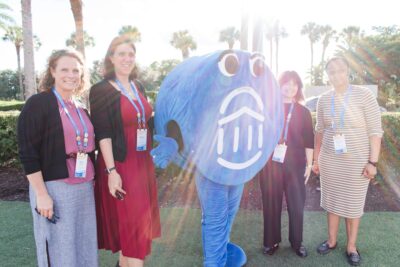Students need career support earlier. Here’s a scalable way colleges can provide it.
A lot is riding on the first year of college. It’s where students form their sense of belonging, choose their academic path, and start imagining their future. But for many, that future still feels blurry. That’s why more schools are exploring how they can introduce career exploration into year one.
In this blog, I’ll share what I’ve learned working with EAB partners who are helping students explore their strengths and career interests early. Simple tools like career simulations give students a low-stakes way to discover their strength, discover what drives them, and make the most of their time at your college.
Research shows that career exploration improves retention and graduation rates
Career development doesn’t need to wait until students have chosen a major. A longitudinal study of more than 14,000 students found that those who participated in career exploration were more likely to stay on track. First-year retention rose from 77.5% to 86.3%, and four-year graduation rates climbed from 43.4% to 58.4%. These results support the practice of introducing career exploration earlier in the student journey, ideally in the first year, through tools and experiences that help students reflect on their interests, strengths, and goals.
Early career exploration can take many forms such as short simulations, advising conversations, or career-themed workshops. When students begin making these connections early, they’re more likely to stay motivated, choose courses with purpose, and build confidence about where they’re headed.
Most importantly, students are actively looking for help with career planning, and many don’t know where to start. In a 2023 Forage study, nearly half (47%) of college students are not confident or only somewhat confident that they know how to get a job after college. Meanwhile, 94% of students in a 2023 NACE survey said they would value faculty guidance on how their skills connect to future careers. This contrast between low confidence and high demand underscores the need for structured career support early in the college journey.
Four common barriers to first-year career exploration
Lack of perceived relevance
Students often don’t see the value of career planning in year one, especially if they’re still undecided.
Staff bandwidth and training
Faculty and advisors want to help but are under-equipped or short on time. They can’t be experts in every field of study.
Too much on the first-year agenda
First-year programs already address a wide range of needs, such as academic success, wellness, and belonging. This means career planning often gets lost because it doesn’t feel as urgent.
Students’ fear of choosing “wrong”
Career planning can feel high stakes for students who are still exploring their identity and interests.
A scalable tool for career exploration: The Forage Career Explorer
The goal of earlier career preparation isn’t to “box” first-year students into a career path, but to give them low-pressure, exploratory tools to better understand their strengths and how they might apply them after graduation. These activities help students clarify their preferences and begin imagining career paths, without pressure to commit or decide too early.
The Forage Career Explorer is a free, 30-60 minute virtual simulation designed specifically for first-year students, to explore foundational skills like problem solving, data analysis, or collaboration. Rather than asking “What do you want to do?”, it invites students to experience four realistic scenarios:
- Leading a student organization
- Working a part-time campus job
- Contributing to an internship
- Supporting a peer through a challenging situation
Each scenario uses a context students already understand to build core workplace competencies like problem solving, data analysis, collaboration, and caregiving. After each experience, students reflect on their natural strengths and preferences. It’s not a test with correct answers, rather it’s a way to “try on” different ways of working and build career confidence through experience.
A Webinar for Navigate360 and Starfish Partners
Navigate360 and Starfish partners can join our upcoming webinar to explore how colleges are using Forage’s Career Explorer to support early career engagement.
Explore free simulations, quizzes, and more at theforage.com.
If you want to learn more about integrating Forage into your curriculum, reach out to [email protected].
How to embed career exploration in existing programming
The Forage Career Explorer demonstrates a key principle: career readiness is most effective when it’s embedded into existing student experiences like coursework, advising, or orientation rather than treated as an additional requirement. The most successful strategies don’t require separate career courses; they weave career conversations into what students are already doing. We’ve identified some natural opportunities for career reflection where simulations like Forage’s can be seamlessly embedded:
-
Academic Touchpoints
- First-year seminars and orientation courses
- Academic advising checkpoints
- Course-based milestone reflections
-
Social and Residential Programming
- Peer mentoring conversations
- Residence hall programming
- Learning community discussions
After any career exploration activity—whether it’s a simulation, reflection exercise, or advising conversation—students should be prompted with questions that connect insight to action:
- “Which scenario felt most natural to you?”
- “What surprised you about how you approached the task?”
- “What’s one campus opportunity you might try next?”
These types of guided questions help students connect the dots between their experiences and future goals, encouraging them to think like professionals as they build their academic foundation.
Getting started: Your early career readiness strategy
1. Audit Your Current Landscape
- What first-year programming already includes reflection or goal setting?
- Where do students naturally discuss their interests and strengths?
- Which staff members are already having career-adjacent conversations?
2. Identify Low-Lift Integration Opportunities
- Could a 30-minute simulation enhance an existing orientation session?
- Would career reflection questions strengthen academic advising meetings?
- Can peer mentors facilitate brief career conversations?
3. Empower Your Team
- Who needs training to feel confident discussing careers across disciplines?
- How can you support staff who want to integrate career conversations but lack time or resources?
- What simple tools would make career discussions more accessible?
Investing in early career readiness pays off
Students don’t need to choose a career in year one—but they do need to start understanding themselves as future professionals. With strategic integration of low-pressure exploration tools, you can help students ask better questions, make more intentional choices, and graduate with genuine confidence about their next steps.
The investment in early career readiness pays dividends in retention, engagement, and student satisfaction. More importantly, it delivers on the promise that higher education should prepare students not just for their next semester, but for their next chapter in life.

More Blogs

Four signs it’s time to break up with your student CRM

Three lessons from 1,200 student success leaders on higher ed’s future
